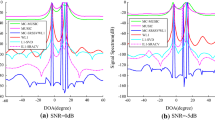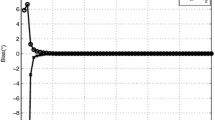Abstract
The received signal may suffer from continuous missing data due to reasons such as antenna damage, which affects the performance of the direction-of-arrival (DOA) estimation. In order to achieve a better DOA estimation performance, this paper presents a matrix recovery DOA estimation method based on the truncated nuclear norm (TrNN) robust principal component analysis (RPCA). Firstly, the received signal recovery and noise reducing problem of a single snapshot is modeled as a low-rank matrix RPCA recovery problem, and the F-norm is used to constrain the noise entries so as to better separate the low-rank received signal from the noise. Secondly, TrNN is introduced into the low-rank matrix RPCA model in order to make better use of the a priori information on the number of signal sources in the received signal. In the process of TrNN optimization, only large singular values are used corresponding to the number of sources for processing, which reduces the computational complexity of the nuclear norm optimization to some extent without losing the target signal information. The proposed algorithm is used to complete the data of all snapshots. Finally, the DOA parameters are estimated by means of subspace theory. Simulation results show that the proposed algorithm achieves better angular parameter estimation performance with associated low-rank matrix recovery at low SNR.





Similar content being viewed by others
References
Shi, J., Hu, G., Zhang, X., Sun, F.: Sparsity-based DOA estimation of coherent and uncorrelated targets with flexible MIMO radar. IEEE Trans. Veh. Technol. 68(6), 5835–5848 (2019)
Schmidt, R.-O.: Multiple emitter location and signal parameter estimation. IEEE Trans. Antennas Propag. 34(3), 276–280 (1986)
Paulraj A., Roy, R., Kailath, T.: Estimation of Signal parameters via rotational invariance techniques-esprit. IEEE Xplore, pp 83–89 (1986)
Bresler Y.: Maximum likelihood estimation of a linearly structured covariance with application to antenna array processing. Spectr. Estim. Model., pp. 172–175 (1988)
Kwon, M., Choi, H.-J.: Learning low-rank representation for matrix completion. In: IEEE international conference on big data and smart computing pp 161–164 (2020)
Xie, T., Li, S., Lai, J.: Adaptive rank and structured sparsity corrections for hyperspectral image restoration. IEEE Trans. Cybern. 52(9), 8729–8740 (2021)
Chen, M., Ganesh, A., Lin, Z.: Fast convex optimization algorithms for exact recovery of a corrupted low-rank matrix. J. Marine Biol. Assoc. 56(3), 707–722 (2019)
Cands, E.-J., Li, X., Ma, Y.: Robust principal component analysis. J. ACM 58(3), 1–37 (2019)
Jiang, G., Mao, X.-P., Liu, Y.-T.: Underdetermined DOA estimation via covariance matrix completion for nested sparse circular array in nonuniform noise. IEEE Signal Process. Lett. 27, 1824–1828 (2020)
Chen, J., Gao, W., Weis, K.: Exact matrix completion based on low rank Hankel structure in the fourier domain. Appl. Comput. Harmon. Anal. 55, 2–3 (2021)
Fei, Y., Cao, H., Wu, Y., Chen, X., Chen, L.: DOA estimation in non-uniform noise using matrix completion via alternating projection. IEEE Open J. Antennas Propag. 2, 281–285 (2021)
Wang, P., Zhang J., Liao, B.: An adaptive SVT-based matrix completion method for DOA estimation in nonuniform noise. In: CIE international conference on radar, pp. 2390–2394 (2021)
Hu, Y., Zhang, D., Ye, J., Li, X., He, X.: Fast and accurate matrix completion via truncated nuclear norm regularization. IEEE Trans. Pattern Anal. Mach. 35(9), 2117–2130 (2013)
Hu, W., Wang, Z., Liu, S.: Motion capture data completion via truncated nuclear norm regularization. IEEE Signal Process. Lett. 25(2), 258–262 (2017)
Taylor, G., Burmeister R.: Training neural networks without gradients: a scalable ADMM approach. J. Mach. Learn. Res. (2016)
Wang, X., Wang, W., Liu, J.: A sparse representation scheme for angle estimation in monostatic MIMO radar. Signal Process 10(03), 258–263 (2014)
Jinli, C., Hong, G., Weimin, S.: A method for fast multi-target localization in bistatic MIMO radar system. J. Electron. Inform. Technol. 31(7), 1664–1668 (2009)
Fei, Y., Cao, H., Wu, Y.: DOA estimation in non-uniform noise using matrix completion via alternating projection. IEEE Open J. Antennas Propag. 11(99), 509–517 (2021)
Funding
This work was supported by the National Natural Science Foundation of China under Grant No. 61971117, by the Natural Science Foundation of Hebei Province under Grant No. F2020501007 and by the S&T Program of Hebei under Grant No. 22377717D.
Author information
Authors and Affiliations
Contributions
Xinyue Lou, Bo Zhang and Fulai Liu wrote the main manuscript text. All authors reviewed the manuscript.
Corresponding authors
Ethics declarations
Conflict of interest
The authors declare that they have no known competing financial interests or personal relationships that could have appeared to influence the work reported in this paper.
Additional information
Publisher's Note
Springer Nature remains neutral with regard to jurisdictional claims in published maps and institutional affiliations.
Rights and permissions
Springer Nature or its licensor (e.g. a society or other partner) holds exclusive rights to this article under a publishing agreement with the author(s) or other rightsholder(s); author self-archiving of the accepted manuscript version of this article is solely governed by the terms of such publishing agreement and applicable law.
About this article
Cite this article
Liu, F., Lou, X., Zhang, B. et al. Truncated nuclear norm matrix recover algorithm for direction-of-arrival estimation. SIViP 18, 3715–3722 (2024). https://doi.org/10.1007/s11760-024-03035-1
Received:
Revised:
Accepted:
Published:
Issue Date:
DOI: https://doi.org/10.1007/s11760-024-03035-1




